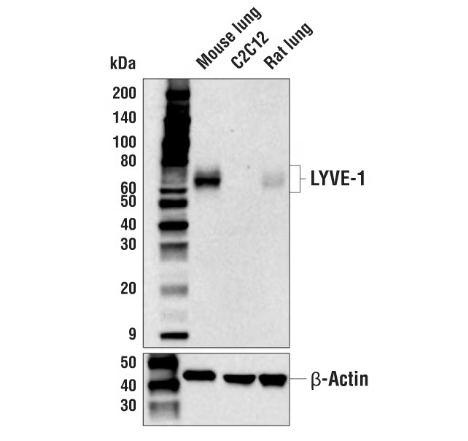 首页>
生物试剂
首页>
生物试剂
商家描述
产品评价(0)
https://www.cellsignal.cn/products/primary-antibodies/lyve-1-e3l3v-rabbit-mab/67538
Supporting Data
REACTIVITY M R
SENSITIVITY Endogenous
MW (kDa) 60-70
Source/Isotype Rabbit IgG
Application Key:
WB-Western Blotting IP-Immunoprecipitation IF-Immunofluorescence
Species Cross-Reactivity Key:
M-Mouse R-Rat
Product Usage Information
Application Dilution
Western Blotting 1:1000
Immunoprecipitation 1:50
Immunofluorescence (Frozen) 1:200 - 1:800
Storage
Supplied in 10 mM sodium HEPES (pH 7.5), 150 mM NaCl, 100 µg/ml BSA, 50% glycerol and less than 0.02% sodium azide. Store at –20°C. Do not aliquot the antibody.
For a carrier free (BSA and azide free) version of this product see product #99900.
Protocol
Select your Protocol
Specificity / Sensitivity
LYVE-1 (E3L3V) Rabbit mAb recognizes endogenous levels of total LYVE-1 protein.
Species Reactivity:
Mouse, Rat
Source / Purification
Monoclonal antibody is produced by immunizing animals with recombinant protein specific to the amino terminus of mouse LYVE-1 protein.
Background
Lymphatic vessel endothelial hyaluronan receptor 1 (LYVE-1), also known as extracellular link domain-containing protein 1 (XLKD1), is a type I integral membrane glycoprotein. LYVE-1 is a CD44 homolog found primarily on lymphatic endothelial cells, but has also been described on hepatic blood sinusoidal endothelia, embryonic blood vessels, Kupffer cells, the islets of Langerhans, cortical neurons, and renal epithelium (1-3). LYVE-1 acts as a receptor for hyaluronan, and plays a role in hyaluronan transport and turnover (4-7). LYVE-1 also mediates the docking and entry of dendritic cells to lymphatic vessels through selective adhesion to hyaluronan in the leukocyte surface glycocalyx (8). Several studies have demonstrated the utility of LYVE-1 as a marker for lymphoid tissues and lymphangiogenesis (9,10).
Mouta Carreira, C. et al. (2001) Cancer Res 61, 8079-84.
Lee, H.W. et al. (2011) Cell Tissue Res 343, 429-44.
Gordon, E.J. et al. (2008) Dev Dyn 237, 1901-9.
Banerji, S. et al. (1999) J Cell Biol 144, 789-801.
Lawrance, W. et al. (2016) J Biol Chem 291, 8014-30.
Prevo, R. et al. (2001) J Biol Chem 276, 19420-30.
Stanly, T.A. et al. (2020) J Biol Chem 295, 5036-5050.
Johnson, L.A. et al. (2017) Nat Immunol 18, 762-770.
Skobe, M. et al. (2001) Nat Med 7, 192-8.
Beasley, N.J. et al. (2002) Cancer Res 62, 1315-20.
Supporting Data
REACTIVITY M R
SENSITIVITY Endogenous
MW (kDa) 60-70
Source/Isotype Rabbit IgG
Application Key:
WB-Western Blotting IP-Immunoprecipitation IF-Immunofluorescence
Species Cross-Reactivity Key:
M-Mouse R-Rat
Product Usage Information
Application Dilution
Western Blotting 1:1000
Immunoprecipitation 1:50
Immunofluorescence (Frozen) 1:200 - 1:800
Storage
Supplied in 10 mM sodium HEPES (pH 7.5), 150 mM NaCl, 100 µg/ml BSA, 50% glycerol and less than 0.02% sodium azide. Store at –20°C. Do not aliquot the antibody.
For a carrier free (BSA and azide free) version of this product see product #99900.
Protocol
Select your Protocol
Specificity / Sensitivity
LYVE-1 (E3L3V) Rabbit mAb recognizes endogenous levels of total LYVE-1 protein.
Species Reactivity:
Mouse, Rat
Source / Purification
Monoclonal antibody is produced by immunizing animals with recombinant protein specific to the amino terminus of mouse LYVE-1 protein.
Background
Lymphatic vessel endothelial hyaluronan receptor 1 (LYVE-1), also known as extracellular link domain-containing protein 1 (XLKD1), is a type I integral membrane glycoprotein. LYVE-1 is a CD44 homolog found primarily on lymphatic endothelial cells, but has also been described on hepatic blood sinusoidal endothelia, embryonic blood vessels, Kupffer cells, the islets of Langerhans, cortical neurons, and renal epithelium (1-3). LYVE-1 acts as a receptor for hyaluronan, and plays a role in hyaluronan transport and turnover (4-7). LYVE-1 also mediates the docking and entry of dendritic cells to lymphatic vessels through selective adhesion to hyaluronan in the leukocyte surface glycocalyx (8). Several studies have demonstrated the utility of LYVE-1 as a marker for lymphoid tissues and lymphangiogenesis (9,10).
Mouta Carreira, C. et al. (2001) Cancer Res 61, 8079-84.
Lee, H.W. et al. (2011) Cell Tissue Res 343, 429-44.
Gordon, E.J. et al. (2008) Dev Dyn 237, 1901-9.
Banerji, S. et al. (1999) J Cell Biol 144, 789-801.
Lawrance, W. et al. (2016) J Biol Chem 291, 8014-30.
Prevo, R. et al. (2001) J Biol Chem 276, 19420-30.
Stanly, T.A. et al. (2020) J Biol Chem 295, 5036-5050.
Johnson, L.A. et al. (2017) Nat Immunol 18, 762-770.
Skobe, M. et al. (2001) Nat Med 7, 192-8.
Beasley, N.J. et al. (2002) Cancer Res 62, 1315-20.
 会员登录
会员登录.getTime()%>)
 购物车()
购物车()

 成功收藏产品
成功收藏产品